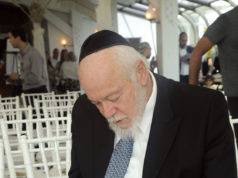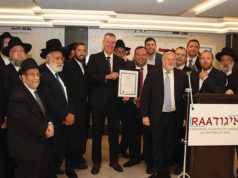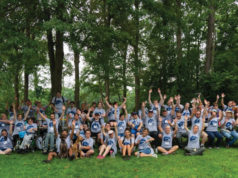
There are Jewish museums throughout the worldone of the most interesting is the South African Jewish Museum, located in central Cape Town on “Museum Mile.” It was officially opened by Nelson Mandela in December, 2000.
The exterior of the museum is clad in Jerusalem stone and offers visitors a truly unique experience with its bold architectural design.
The main body of the museum faces a paved landscaped court linking the Old Synagogue (1863) the first synagogue built on South African soiland the Albow Centre, which comprises the South African Jewish Museum Shop, the Gitlin Library, the Caf Riteve (which is kosher), the Cape Town Holocaust Centre which is dedicated to creating a more caring and just society in which human rights and diversity are respected; and Israel Abrahams hall. Israel Abrahams held the position of Chief Rabbi of the Cape Town Hebrew Congregation for more than thirty years
The entrance is situated in the Old Synagogue. This is linked to the new gallery by a bridge, which symbolizes the bridge between the old and the new and the gangplank to the shores of the Cape and immigrants

Inside, the museum is interactive and hi-tech, using different media to present highlights of South African history, and transforming the Jewish community’s story into a vital account of individual and organizational roles and contributions. Dynamic displays reveal the community’s response to the moral and political challenges that confronted them.
Jews have lived in South Africa since the late 1400s but did not arrive en masse until the 1820s. The first congregation in South Africa, known as the Gardens Shul, was founded in Cape Town in November 1841, and the initial service was held in the house of Benjamin Norden. Norden, Simeon Markus along with a score of others arriving in the early 1930s, were commercial pioneers, especially the Mosenthal brothersJulius, Adolph and Jameswho started a major wool industry. They were the originators of the mohair industry.
From 1849 to 1886, Aaron and Daniel de Pass were the largest shipowners in Cape Town, and leaders of the sealing, whaling, and fishing industries. Jews were among the first to take to ostrich-farming and played a role in the early diamond industry.


ews also played some part in early South African politics. At the same time, they faced substantial anti-Semitism. Though freedom of worship was granted to all residents in 1870, in 1894 Catholics and Jews were debarred from military posts, from the positions of president, state secretary, or magistrate and from membership in the First and Second Parliaments. These positions were restricted to persons above 30 years of age with permanent property and a longer history of settlement. They were also excluded from state-subsidized schools.
 The South African gold rush began after 1886, attracting many Jews fleeing Russian pogroms in the Lithuanian province of the Russian Empire. The Jewish population of South Africa numbered approximately 4,000 in 1880; by 1914 it had grown to more than 40,000. So many of the Jewish came from Lithuania, that some referred to the population as a colony of Lithuania. Johannesburg was also occasionally called “Jewburg.”
The South African gold rush began after 1886, attracting many Jews fleeing Russian pogroms in the Lithuanian province of the Russian Empire. The Jewish population of South Africa numbered approximately 4,000 in 1880; by 1914 it had grown to more than 40,000. So many of the Jewish came from Lithuania, that some referred to the population as a colony of Lithuania. Johannesburg was also occasionally called “Jewburg.”
Although the Jews were allowed equal rights in the early 1900s, they again became subject to persecution in the days leading up to World War II. The Quota Act of 1930 was intended to curtail the entry of Jews from Eastern Europe. Then in 1937, the Aliens Act, motivated by a sharp increase the previous year in the number of German Jewish refugees, brought immigration to almost a complete halt. Some Jews were able to enter the country; a total of six-and-a-half thousand Jews arrived between 1933 and 1939.
After the war, the situation began to improve, and a large number of South African Jews went to Israel. In 1953 South Africa’s Prime Minister, D. F. Malan, became the first foreign head of government to visit Israel, although the trip was a “private visit” rather than an official state visit. This began a long history of cooperation between Israel and South Africa.
Jews also played some part in early South African politics. At the same time, they faced substantial anti-Semitism. Though freedom of worship was granted to all residents in 1870, in 1894 Catholics and Jews were debarred from military posts, from the positions of president, state secretary, or magistrate and from membership in the First and Second Parliaments. These positions were restricted to persons above 30 years of age with permanent property and a longer history of settlement. They were also excluded from state-subsidized schools.
The South African gold rush began after 1886, attracting many Jews fleeing Russian pogroms in the Lithuanian province of the Russian Empire. The Jewish population of South Africa numbered approximately 4,000 in 1880; by 1914 it had grown to more than 40,000. So many of the Jewish came from Lithuania, that some referred to the population as a colony of Lithuania. Johannesburg was also occasionally called “Jewburg.”
Although the Jews were allowed equal rights in the early 1900s, they again became subject to persecution in the days leading up to World War II. The Quota Act of 1930 was intended to curtail the entry of Jews from Eastern Europe. Then in 1937, the Aliens Act, motivated by a sharp increase the previous year in the number of German Jewish refugees, brought immigration to almost a complete halt. Some Jews were able to enter the country; a total of six-and-a-half thousand Jews arrived between 1933 and 1939.
After the war, the situation began to improve, and a large number of South African Jews went to Israel. In 1953 South Africa’s Prime Minister, D. F. Malan, became the first foreign head of government to visit Israel, although the trip was a “private visit” rather than an official state visit. This began a long history of cooperation between Israel and South Africa.
From the time of their arrival, a significant number of Jews challenged the inequities of South Africa’s political system, and fought for an unprejudiced society. Some were motivated by traditional Jewish teachings and values, others by ideals of liberalism and socialism. After the election of the Nationalist Government in 1948, many Jews fought for political justice, for tolerance and liberty, and for the rights of workers. Their efforts were evident in mainstream and radical politics, legal aid, educational, cultural and health care initiatives, philanthropic endeavours, student activism, trade unions, underground resistance and the delegitimization of the apartheid state from abroad.
In 1980, 32 years after the creation of apartheid, the South African Jewish Board of Deputies passed a resolution urging “all concerned, in particular members of our own community, to cooperate in securing the immediate amelioration and ultimate removal of all unjust discriminatory laws and practices based on race, creed or color.”
A few rabbis spoke out against apartheid early, but they failed to gain support and it was not until 1985 that the rabbinate as a whole condemned apartheid.
This incredible history is represented at the South African Jewish Museum, which is a major attraction for local and international tourism. On view are rare Judaica artifacts, animated video footage and an award winning documentary film Nelson Mandela. A Righteous Man, which is screened throughout the day. Mandela said, “I have found Jews to be more broad-minded than most whites on issues of race and politics, perhaps because they themselves have historically been victims of prejudice.”
Other exhibits include a diamond dealer’s store, three models projecting scenes from early Johannesburg, including several synagogues. There is also a typical smous (itinerant pedlar cart) from which a variety of goods such as textiles, buttons, costume jewelry and kitchen utensils would have been sold to farmers, who were isolated from big towns.
In the Discovery Centre, visitors will find a bank of computers which provide online information about South African villages and towns, home to many pioneering Jewish communities. The special section on migration contains in-depth information on immigrants who made their way to South Africa. A search facility on family trees is also accessible.
Also on view are the traveling Aron Kodesh presented to Theodor Herzl by the Jews of Vilna, in 1860; the first Torah scroll brought to South Africa by Aaron de Pass, an olive wood Megillat Esther and a shofar.

Since the museum opened there have been many exhibitions, including Marc Chagall: HadassahFrom Sketch to Stained Glass Windows. Marc Chagall’s granddaughter, Meret Meyer Graber, officially opened the exhibition, which comprised a progression of 62 preparatory sketches for Chagall’s stained glass windows in the Hadassah Synagogue in Jerusalem. A photographic exhibition of Chagall at work accompanied the main exhibition, which included a recreated model of the windows and replicas of the four trial windows created by the artist. A video on Chagall’s life completed the exhibition.
The museum is located at 88 Hatfield Street, in Capetown and is open Sunday to Thursday from 9 am to 5 pm and Fridays from 9 am to 3 pm. It’s close Saturdays and Jewish holidays. If you’re planning a trip to Capetown, don’t miss this exceptional museum.
This incredible history is represented at the South African Jewish Museum, which is a major attraction for local and international tourism. On view are rare Judaica artifacts, animated video footage and an award winning documentary film Nelson Mandela. A Righteous Man, which is screened throughout the day. Mandela said, “I have found Jews to be more broad-minded than most whites on issues of race and politics, perhaps because they themselves have historically been victims of prejudice.”
Other exhibits include a diamond dealer’s store, three models projecting scenes from early Johannesburg, including several synagogues. There is also a typical smous (itinerant pedlar cart) from which a variety of goods such as textiles, buttons, costume jewelry and kitchen utensils would have been sold to farmers, who were isolated from big towns.

In the Discovery Centre, visitors will find a bank of computers which provide online information about South African villages and towns, home to many pioneering Jewish communities. The special section on migration contains in-depth information on immigrants who made their way to South Africa. A search facility on family trees is also accessible.
Also on view are the traveling Aron Kodesh presented to Theodor Herzl by the Jews of Vilna, in 1860; the first Torah scroll brought to South Africa by Aaron de Pass, an olive wood Megillat Esther and a shofar.
Since the museum opened there have been many exhibitions, including Marc Chagall: HadassahFrom Sketch to Stained Glass Windows. Marc Chagall’s granddaughter, Meret Meyer Graber, officially opened the exhibition, which comprised a progression of 62 preparatory sketches for Chagall’s stained glass windows in the Hadassah Synagogue in Jerusalem. A photographic exhibition of Chagall at work accompanied the main exhibition, which included a recreated model of the windows and replicas of the four trial windows created by the artist. A video on Chagall’s life completed the exhibition.
The museum is located at 88 Hatfield Street, in Capetown and is open Sunday to Thursday from 9 am to 5 pm and Fridays from 9 am to 3 pm. It’s close Saturdays and Jewish holidays. If you’re planning a trip to Capetown, don’t miss this exceptional museum.



